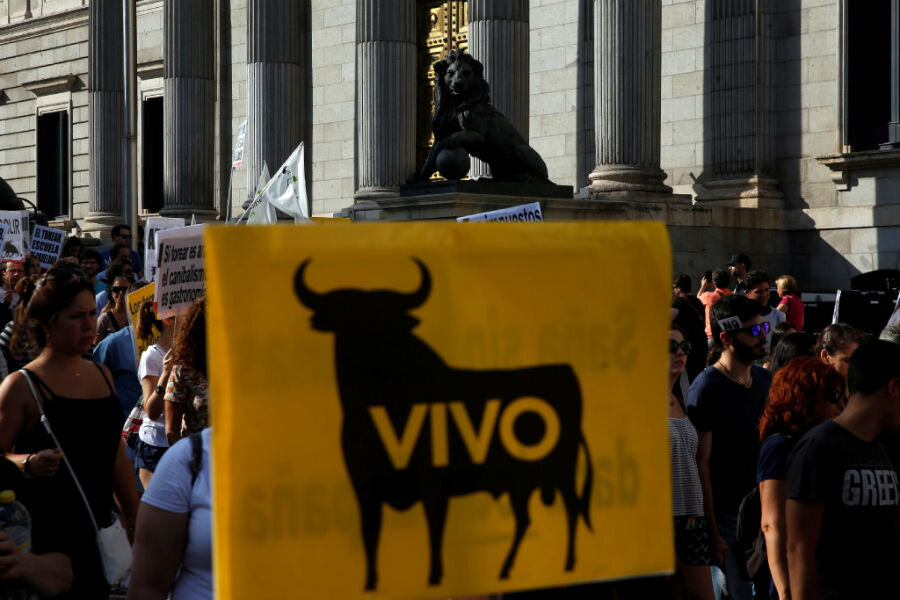In Madrid, the largest-ever bullfighting protest
Loading...
For many, the mention of bullfighting evokes a fantastical image: a colorfully attired matador deftly sidestepping a charging bull with a flourish of a red cape, as the crowd cheers admiringly from the stands. The almost gladiatorial spirit of the sport is a fascinating and bloody relic of another age as the animal is killed at the end of the dangerous contest.
For decades, however, animal rights activists have decried the needlessly cruel spectacle of killing a bull before a live audience. Even in contests which do not end in the death of the bull, the animal is frequently aggravated, injured, and generally subjected to unnecessary stress even before being released into the ring. More and more Spaniards have joined activists against the sport, which has increasingly waned over the years.
And now, it seems as if the bloody Spanish tradition may be on its way out. On Saturday, thousands of protesters took to the streets of Madrid to protest bullfighting. The massive rally is an indicator of a major shift in Spanish opinion against the sport in recent years, despite its associations with traditional Spanish culture.
Bullfighting in its current form has remained relatively unchanged in Spain since 1726, when Francisco Romero, a famous bullfighter, introduced the estoque (sword) and the muleta (the red cape used to guide the bull during the fight) into the bullfighting ring. Before that, Spanish bullfighting was largely a sport of the Spanish nobility, carrying on a tradition of public bull-taunting spectacles that had existed since Visigoth rule of Spain in the 5th century.
But times have changed.
"Bulls feel and they suffer," Chelo Martin Pozo, a 39-year-old from Seville who had come to Madrid for the Saturday rally, told The Guardian. "Bullfights are a national shame and if they represent me, then I am not Spanish."
The protest was organized by the Party Against Mistreatment of Animals (PACMA), a Spanish political party that runs on a platform of animal rights and social justice. A spokesman for the PACMA told Reuters that the event was the largest anti-bullfighting protest in history. Protesters at the rally held signers with slogans such as "Bullfighting, the school of cruelty," and "Bullfighting, a national shame."
While there are still many bullfighting fans, called "aficionados" in Spain, support for the tradition has been dropping significantly across the country. Reuters reports that a poll in January, carried out by animal welfare organization World Animal Protection, found that 19 percent of adults in Spain supported bullfighting, while 58 percent opposed it. While these numbers seem to foretell bullfighting's demise, the issue remains divisive in Spain, with support and opposition frequently falling along party lines, according to Reuters.
In 2013, while under the center-right People's Part (PP), Spain's parliament moved to protect bullfighting by declaring it a cultural asset. This enabled the sport to receive public funding. Madrid's leftist mayor, on the other hand, withdrew subsidies for bullfighting schools in Spain's capital.
The surge against bullfighting has been fueled by recent victories against bullfighting lobbyists over the past few years, including the 2011 banning of the sport altogether in the Catalonia region. But the more immediate trigger for the protest was a graphic video released by PACMA that showed a baby bull being killed by amateur bullfighters. The video went viral, getting over 20 million views in less than 24 hours, according to NPR.
"Many Spaniards were outraged that such torture is legal here," Pozo told The Guardian.
According to Humane Society International, approximately 250,000 bulls are killed every year in bullfights. Other bull-taunting events in Spain, such as the famed "Running of the Bulls," have attracted tourists from around the world. But despite their historical and cultural significance, these events finally seem to be in decline.
"It makes me sad that some people want to have fun at the expense of another living being. There are other ways to pass the time," Mari Paz Rojo, an administrative assistant, told Reuters as she marched through the capital with thousands of other demonstrators.
"We don't want Spaniards to be identified with bullfighting, this is not our national fiesta," she added.








